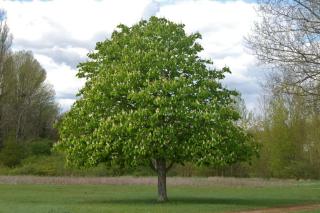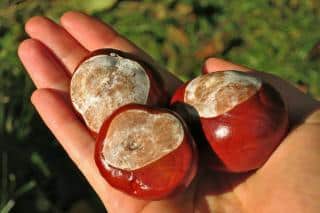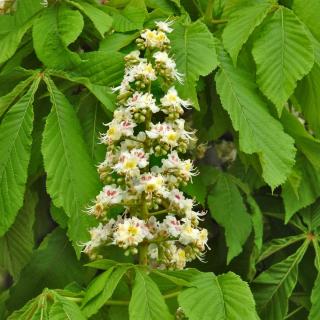

The horse chestnut tree is a favorite of schoolyards: its famed “conkers” are an infinite source of enjoyment!
Horse Chestnut tree facts
Name – Aesculus hippocastanum
Family – Spindaceae
Type – tree
Height – 50 to 150 feet (15 to 45 meters)
Exposure – full sun
Soil: rich and cool – Foliage: deciduous – Flowering: May

They grow very fast and their root development will have had a running start before winter.
It doesn’t need any pruning.

This tree has the advantage of growing very quickly, of bearing beautiful flowers in spring and of offering horse chestnuts in fall, except the double-flowered varieties that can’t produce any fruits.

Horse chestnuts, though they’re not edible, nonetheless are very useful to treat certain ailments related to venous deficiency and more.
Great activity for your children: germinate a horse chestnut in a small container filled with soil mix. Water just a bit and see it grow!
It’ll be ready for planting in the garden in spring.
My horse chestnut has a single trunk up for about 2 feet
Then a branch is started that grows pretty straight up rather than out to the side. Should I leave it alone?
It will form a crotch which I know can be a weak spot
Do I need to prune or let it be more bushy in shape?
I have got a Horse Chestnut given it’s about 1 ft high in a pot. What is the best way to plant in the garden thanks.
Hi Margaret! That’s a nice gift, but for sure you’ll have to plant it out in the garden because a pot will quickly get too small!
It’s not so difficult to transfer it to the garden. What you’ll need is a small hand trowel to dig a hole that’s about twice as large as the pot is (wide and deep). At the bottom of the hole, spread about two inches/5 cm of gravel to ensure drainage so roots won’t rot when it rains. Buy some soil mix or scrape up some nice, rich soil from under a bush or tree nearby, and mix that with the garden soil from the hole you just dug out (same volume for both, or 1:1 ratio). Form a small mound atop the gravel so you can rest the pot in such a way that the root collar (where the trunk starts) is slightly higher than the surrounding ground level, about two inches or 5 cm. Tease the conker tree from the pot gently, and if roots are running round and round try to unravel them. Place the clump on the small mound, spread the roots like a star/web to each side, and then fill the rest of the hole with the mix you prepared earlier. Water abundantly, spread mulch around the tree but leave the trunk free (don’t pile mulch around the trunk). There are more tips on how to transplant trees here, like preparing root dip and avoiding transplant shock, etc. But for a horse chestnut you shouldn’t have any problems just keeping it simple.